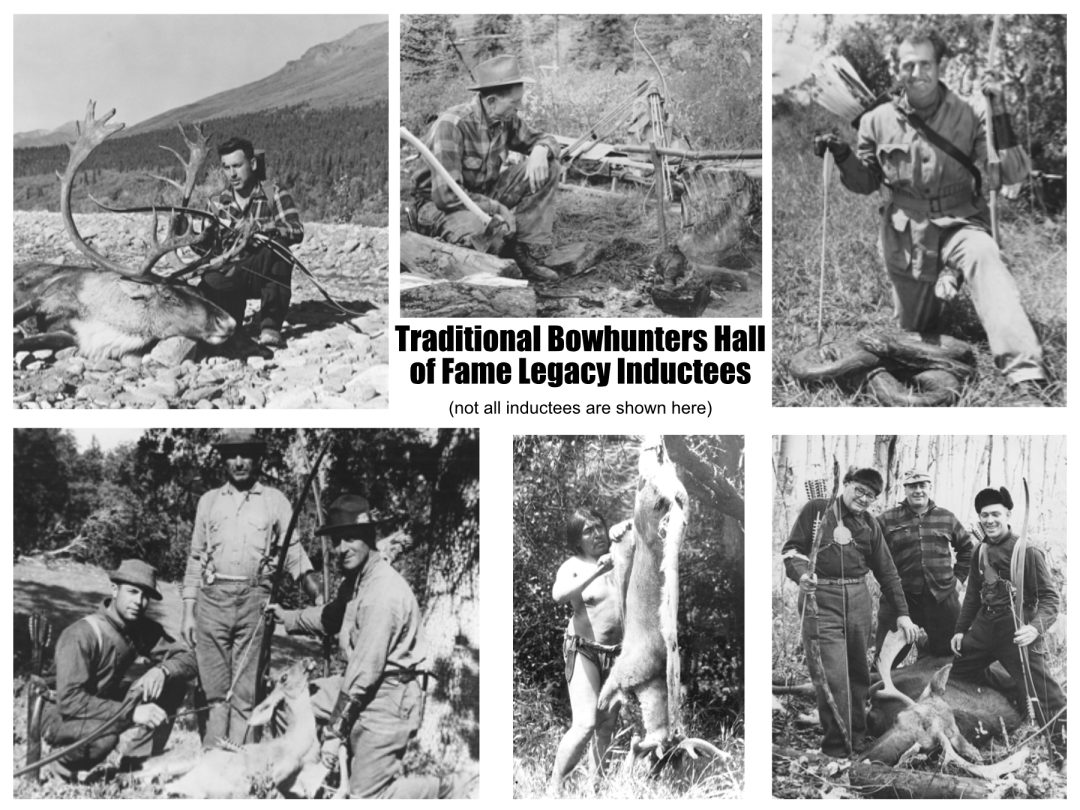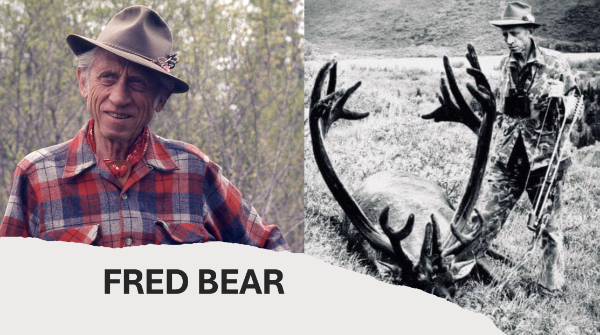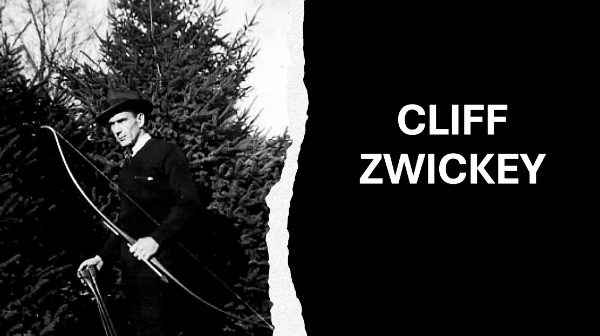Fred Bear | Roy Case | William “Chief” Compton | Howard Hill | Ishi | Art Laha | Bob Lee | Aldo Leopold | Jay Massey | Bill Negley | Ben Pearson | Saxton Pope | Glenn St. Charles | Chester Stevenson | Bob Swinehart | Maurice and Will Thompson | Ken and Walt Wilhelm | Art Young | Cliff Zwickey
March 5, 1902 – April 27, 1988
Where do you begin the story of a man, who perhaps more than any other in our modern era, has been an inspiration to generations of hunters who dreamed of following in his size 13 footsteps? Perhaps it was after viewing the 1926 Art Young silent film, Alaskan Adventures in Detroit, and then soon thereafter, meeting Art at a Rotary Club gathering. Perhaps it was in 1929, when Fred hunted whitetail deer for the first time with his lemonwood bow. Or perhaps it was in June of 1938, when his first national ad appeared in Ye Sylvan Archer, the premier archery magazine of the day. The ad read, in part “BEAR PRODUCTS COMPANY” and offered target faces, quivers, arm guards, bow cases, and tassels for wholesale and retail.
Regardless of where we begin his story, it’s worth noting that whatever event most inspired Fred Bear to his prominence in the world of bowhunting, thousands upon thousands of today’s traditional bowhunters have similarly been inspired and drawn to this lifestyle by his life’s work.
Revered as “Papa Bear” by many, Fred traveled the globe for four decades, with bow in hand, in pursuit of all things wild. His travels took him to remote places in India, Africa, Alaska, Canada and throughout the United States. He inspired us with his writings in such magazines as Outdoor Life and also in books. The Archer’s Bible and Fred Bear’s Field Notes should be on every traditional bowhunter’s reading list. He inspired us with scores of TV appearances, the likes of The American Sportsman series on ABC’s Wide World of Sports, and he even appeared on The Tonight Show to introduce his way of hunting to a different group of people. He inspired us too, with numerous videos with engaging names like The Restless Spirit, Kodiak Country, The Oldest Game, and more.
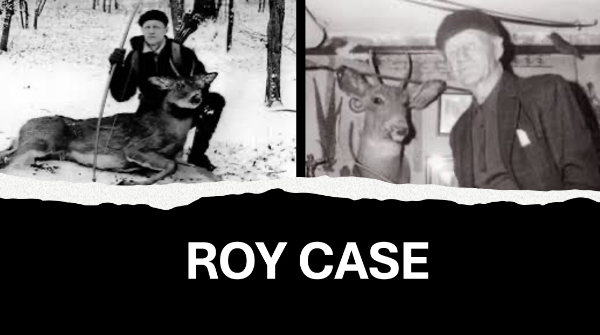
June 9, 1888 – August 17, 1986
Roy Case penned the following words to begin his May, 1929 article in the periodical, Ye Sylvan Archer:
“January, February, March what dreary months for the snowbound Archer in the Middle west! We have to expend all our pent up energy making and repairing equipment and reading all the old Archery books of which there are too few and wishing another Saxton Pope or Maurice Thompson would come forward to enrich our Archery literature.”
This was the first of a handful of articles in that early archery publication, and these words offer just a hint of the impact that Roy Case had on bowhunting and our bowhunting seasons.
In the State of Wisconsin, in 1930, the only legal method of hunting for whitetail deer was with a firearm. It had been that way for the past 79 years. But Roy petitioned Wisconsin’s chief game warden and received written permission to hunt with his bow, thus making him the first legal licensed bowhunter in our modern era. It was only four short years later that Wisconsin was to have the first authorized bowhunting season in the U.S., and other states followed. That’s some kind of influence on our way of life!
It shouldn’t be surprising then to learn that a man with that kind of drive helped organize Wisconsin’s Bowhunter Association. His influence continues to this day. With the knowledge and experience he gained from the commercial manufacture and sale of broadheads for nearly three decades, he was able to influence and assist in the development of some of the standards that remain in effect today.
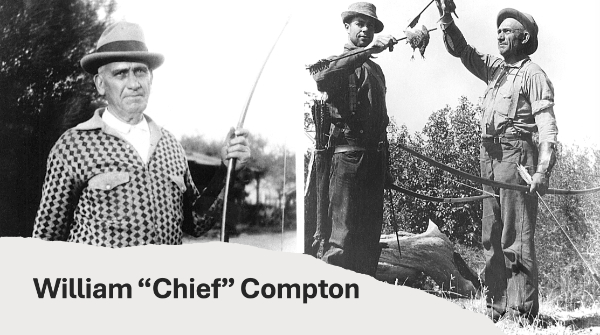
September 28, 1863 – May 17, 1938
Why would William (Will) John Compton, born near Flint, Michigan in 1863, be better known to many us as “Chief” Compton? That’s a relatively easy question, but keep following to learn the answer.
At the age of 7, Will Compton moved with his family to Nebraska and spent time with the Sioux Indians. He learned their style of hunting and of crafting bows and arrows. Certainly the experience with the Sioux helped spark his interest in hunting and making his own hunting tackle.
Here’s how Saxton Pope introduces us to Will Compton in his classic, Hunting with the Bow and Arrow. “When Ishi started to shoot with me, one bowman after another appeared on the scene to join us. Among the first came Will Compton, a man of mature years and many experiences. Brought up on the plains, he learned to shoot the bow with the Sioux Indians. As a boy of fourteen he shot his first deer with an arrow. From that time on, deer, elk, antelope, birds of all sorts and even buffalo fell before this primitive weapon. He later hunted with the gun until the very ease of killing turned him against it. So when he came to us, he was a seasoned archer. Upon a visit to a Japanese archery gallery in the Panama-Pacific Exposition he met for the first time Arthur Young, also an expert hunter with the gun. A friendship sprang up between them, and Compton taught Young to shoot the bow.
Compton had worked in the shop of Barnes, the bowmaker of Forest Grove, Oregon and later he went into the Cascade Mountains to cut yew staves with an idea of selling them to the English bowyers. The Great War of 1914 prevented this, and so we had an unlimited supply of yew wood for use.
We three gravitated together and shot with Ishi until his last sickness and departure. Then our serious work began. We found it not only a delightful way of hunting, but a trio makes success more certain in the field.”
That doesn’t answer our initial question, but it does pretend a hint. Given that this trio of Pope, Young, and Compton spent so much time together and learning of his time spent with the Sioux, Saxton Pope and Art Young gave him the name “Chief”, and now, all these decades later, it’s fair to say that the nickname stuck.
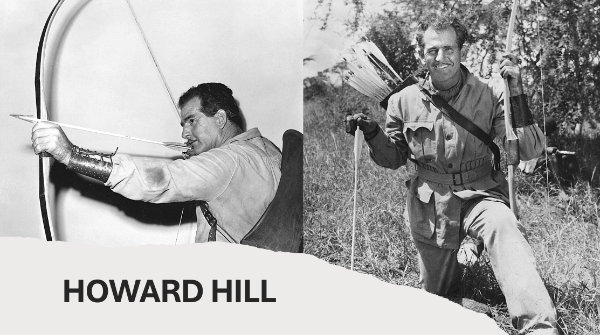
November 13, 1899 – Feb 4, 1975
The ‘world’s greatest’ is a phrase you can’t ignore when selecting members of any Hall of Fame. Known as the ‘world’s greatest archer’, Howard Hill was an exceptional athlete and his skills with the bow were unmatched. He loved everything about the longbow. He loved to shoot them. He loved to make them. He loved making arrows, field points, and broadheads. He loved promoting archery and hunting with his longbow. He spent his lifetime doing all of the aforementioned.
Through his full feature length movie, movie shorts, archery demonstrations, books, and articles, he was one of the most influential bowhunting archers of his day. It would be unforgivable to not mention the name Howard Hill when listing inductees into the Traditional Bowhunters Hall of Fame. To list all of his contributions would be difficult in this allotted space, these are but a few: Full Feature Movie, Tembo (1953); Movie Shorts, King of Archers, Hunting the Devil Cat, It’s Done with Arrows, and many more; Publications, Hunting the Hard Way (1953) and Wild Adventure (1954). His fame drew many to our way of life.

1860 – 1916
Ishi belonged to the Yahi Tribe, a subgroup of the Yana Native American people. He was the last of his tribe and arguably the last Native American to live in a truly wild and traditional manner.
He left his native haunts along Deer Creek, lying beneath Mount Lassen in Northern California in 1911. Ishi was found in starving condition by a local rancher. Ultimately, he ended up under the care of Anthropologists at the Museum of Anthropology in San Francisco. It was there that he met and befriended Dr. Saxton Pope who was fascinated by Ishi’s resourcefulness in making and using primitive archery gear, his survival skills, and insights into animal behavior, bowhunting, and the natural world.
Ishi lived for five years in the white man’s world before he eventually died of tuberculosis. During his healthy years, Saxton Pope, Art Young, and Will “Chief” Compton all accompanied Ishi on hunting trips. These men reported that Ishi was very masterful at flint-knapping obsidian points to a razor edge and his preferred bow material was mountain juniper. Ishi was a deadly shot on big and small game but a poor shot on targets. His forte was animal knowledge and pure bowhunting skill. He left a huge impact on America’s best bowhunting pioneers and demonstrated that being an efficient and self-reliant bowhunter was truly a lifestyle.

Jan 9, 1920 – Jan 31, 1996
From Winchester, Wisconsin, Art received his first bow as a teenager in 1936. That was the beginning of a lifetime of adventure with the bow. He hunted in 48 of our 50 states.
Art hunted numerous North American game animals. An account of one of his trips to Alaska can be seen in the video, No Land for the Timid that he narrated.
He published many stories of his exploits in Outdoor Life magazine to promote the bowhunting lifestyle. He was a guide, not only in his home state of Wisconsin, but also guided during many of his 52 trips to Alaska.

May 1, 1928 – February 4, 2021
Bob Lee loved archery and the entire lifestyle associated with bowhunting. That love inspired Bob to found Wing Archery in Houston, Texas in 1951. Bob was only twenty-three years of age at that time.
A few of the words you might hear used to describe Bob, are determined, inspirational and innovative. In 1959, Bob was determined to lobby the State of Texas to offer an archery-only hunting season. He was successful in that effort. As an example of his innovation and creativity, in 1963, he is credited with developing and producing the very first three-piece, takedown recurve. It is one of the most popular styles of recurves that is still produced today.
The predecessor to the Archery Manufactures Association (AMO) was the Archery Manufacturers and Dealers Association. Bob collaborated to help develop that organization along with some of the industry standards that we still recognize today. After selling Wing Archery to Head-Ski Corp. (later AMF-Head) in 1968, he remained with the company in a leadership role for a few years. But he wasn’t done. It was in 1989, that Bob returned with his son Rob, to create Bob Lee Archery. In the following years, he could often be found at sportsman’s shows and 3D archery tournaments promoting their new line of finely crafted traditional recurves and longbows. Bob Lee was a ‘force’ in the traditional bowhunting community for over 60 years.
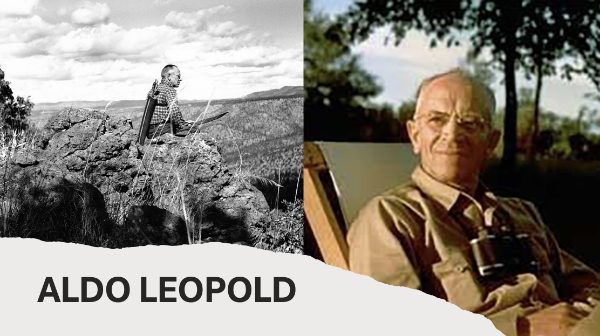
1887 – 1948
Aldo Leopold was a bowhunter, naturalist, ecologist and conservationist. While not known mainly for bowhunting, his essays and quotes on holding the line on the incessant advance of technology in outdoor sports are widely known. He rightly felt they diminished the entire idea of wild places and the pursuit of wildlife with gun, longbow or fishing pole.
He crafted his own longbows and wood arrows, and did the same for friends. He is regarded as the “father of modern conservation” and was a prolific writer of many books and articles on the importance of keeping ethics and preservation of the land in the forefront of public thought and perception. His most well-known book is, A Sand County Almanac and should be a “must read” for anyone that enjoys nature and the pursuit of game in an ethical manner.

1941 – 1997
Born in Oklahoma, Jay moved to Alaska in 1968 and never looked back. During his life that was cut short by cancer, he was a prolific writer of four books on bowhunting, along with many magazine articles for the likes of Gray’s Sporting Journal, Bowhunter Magazine and Traditional Bowhunter Magazine, among others.
Jay worked for the Alaska Department of Fish & Game, the Alaska Board of Game and, along with friends Dick Hamilton, Doug Borland and pilot, Ernie Holland, pioneered the famed Moose John River and hence, started Moose John Outfitters. Jay, Dick, and Doug also produced and printed the short-lived Alaska Bowman magazine.
Jay was involved in founding the Alaska Bowhunters Association, Alaska Longbow Society, and Alaska Moose Federation. He served on the boards of both the Alaska Bowhunters Association and the Council of the Professional Bowhunters Society.
Jay was a very successful bowhunter taking many species of big game with his self-made longbows and arrows including blacktail deer, moose, caribou and black bear as well as myriad small game animals. Jay’s views on ethics in the pursuit of game are well-known and as such he has always been held in high esteem by his peers.
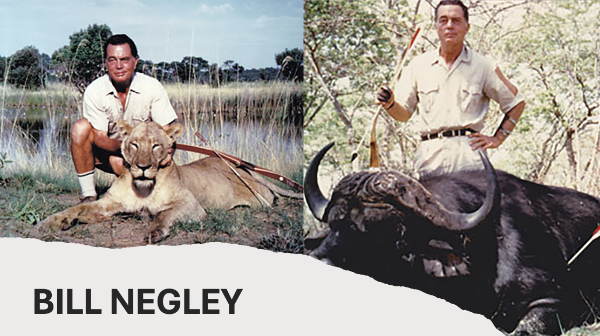
1914 – 2006
Bill Negley was a life-long hunter, fisherman, and conservationist. He began bowhunting in the 1950s, when “modern” bowhunting was still in its humble beginnings and not yet popular in the mainstream of hunting of that time. He went on an African safari and after bagging fifteen animals (fourteen various antelope species and one lion) in fifteen shots with a rifle, he concluded that it wasn’t fair to the animals and was not satisfying to him to hunt in this manner.
Bill took up the recurve bow and after several months of trial and error and rigorous training, he successfully killed a javelina and two deer with his chosen equipment. He was extremely competitive and while participating in a game fishing tournament, his tournament partner, Bill Carpenter bet him $10,000 that he couldn’t kill an elephant with his bow. In February of 1957, Bill traveled to Belgian Congo where he successfully killed two African elephants with his 100 pound-plus longbow and no rifle backup! In 1966, Bill successfully killed the remaining four animals that comprise the “Big Five” of African game: Cape buffalo, black rhino, leopard, and lion, becoming the only person to ever accomplish this feat with no rifle backup. In 1967, he traveled to the far north Arctic where he successfully killed a polar bear with his recurve bow. He always hunted with fair chase in mind.
Bill was a prolific bowhunter and his many trophies can still be viewed at the amazing Buckhorn Saloon and Museum in San Antonio, Texas. He was inducted into the Lone Star Bowhunters Hall of Fame. His African safari adventures can be watched in the documentary film, Moments of Truth. He also put his thoughts and memories on paper and wrote the book, Archer in Africa.

November 16, 1898 – March 2, 1971
Ben Pearson was not only an accomplished bowhunter who hunted across the entirety of North America, he also performed archery demonstrations across the country as well. His archery tackle was sold in locations from local corner gas stations to national retail outlets like Sears and Roebuck, Co.
He was an inventor and an engineer, and he developed many of the very first production-line archery tackle manufacturing machines in his Pine Bluff, Arkansas factory, making the Ben Pearson Company the largest archery manufacturer in the world from the 1940s through 1960s. Many collectors still prize numerous versions of his ‘ribbed’ broadheads.
Perhaps the most famous of his broadhead designs however, was the Deadhead that was developed in 1963, and first produced in 1994. Many of his exploits afield were filmed, and can still be found on the internet today. His influence on our current day traditional bowhunter community is undeniable.

September 4, 1875 – August 8, 1926
Saxton Pope was raised in a military family with a love of the outdoors and, as a typical ruggedly raised boy looking for adventure, shot a bow and arrow as a youth. Gifted as an athlete and scholar, he became a respected surgeon setting up a practice in Monterey, CA. It was through his relationship with Ishi, the only surviving member of the Yahi Tribe, that Saxton Pope became a passionate bowhunter. He met Ishi through Will Compton, and with Art Young, the group honed their woodsmanship and hunting skills shooting numerous small game in California. Ishi passed in 1916, and the three hunters continued hunting together, taking deer, black bears, and mountain lions.
Eventually, adventure called farther afield, and Pope and Young ventured to Yellowstone Park with their hand-made bows and steel broadheads to hunt the most dangerous beast in the west, the grizzly bear. They took six total, donating the mounts to the California Academy of the Sciences. Soon after, they traveled to Africa, where they successfully arrowed eland, waterbuck, wildebeest, Thompson gazelle, and numerous other species. The taking of several lions was the trip’s highlight and is chronicled in Pope’s classic book The Adventurous Bowman. Pope wrote many books on archery, hunting, and Ishi and his Yahi tribe but is best known for Hunting with the Bow and Arrow and The Adventurous Bowman, and along with his frequent hunting partner Art Young is rightfully known as one of the fathers of modern bowhunting.
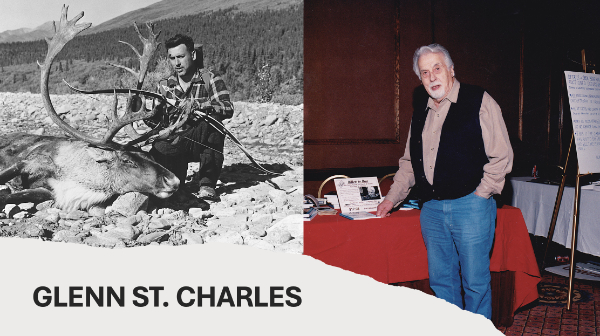
December 15, 1911 — September 19, 2010
Glenn St. Charles was born in Alpena, Michigan, but his father, a timber cruiser, saw that the Northwest was the place to be for his trade. His first taste of archery was shooting bows along the shores of Puget Sound near his home in Fauntleroy and made his first bow from a stave of Tennessee cedar backed with hickory in 1927 for his Boy Scout Merit Badge.
In 1938, he made his first yew bow and became involved with field archery. Within a few years, he was making bows for all his friends and conducted bow making classes. In 1940, he helped Kore Duryee and Bert Wallis form the Washington State Archery Association and served as its President and Big Game Chairman for many years before he was elected Vice President of the NFAA.
Glenn served on many positions in archery over the next two decades before founding the Pope & Young Club in 1961 and was elected as the first President of the Club in 1967. Over the years, he was awarded an Honorary Life Membership in many bowhunting organizations.
Some highlights of Glenn’s involvement in archery and bowhunting were founding Northwest Archery Company, designed three broadheads: the handmade Thunderbolt in 1945 and the manufactured and very popular Micky Finn in 1953, as well as the unique St. Charles Backquiver; and the widely popular Thunderbird recurve from 1953 to 1960 (his oldest son Jay still builds the Thunderbird today).
Glenn has penned numerous articles for archery, bowhunting, and other outdoor magazines, as well as publishing his first book, Billets to Bows, teaching readers how to make selfbows. He has been a prolific speaker for many local, state, and national archery and bowhunting organizations, and became the 40th Inductee into the Archery Hall of Fame in 1991.
Last, but not least, his piece “It’s Time” that was printed in the Dec/Jan 1996 issue of Traditional Bowhunter® Magazine led to the eventual founding of the Compton Traditional Bowhunters. Glenn was one of the Founders of Compton, which was established in May of 1999 and continues today as the largest traditional-only organization in the nation.
Glenn’s capstone input to a long and dedicated life to promoting and protecting traditional bowhunting was his magnificent book, Bows on the Little Delta that not only is a wonderful autobiography of his life but also highlights his pioneering the Little Delta bowhunt in 1957, 1958, and 1959. His place in traditional bowhunting is unmatched when looking at the lifestyle we all enjoy.
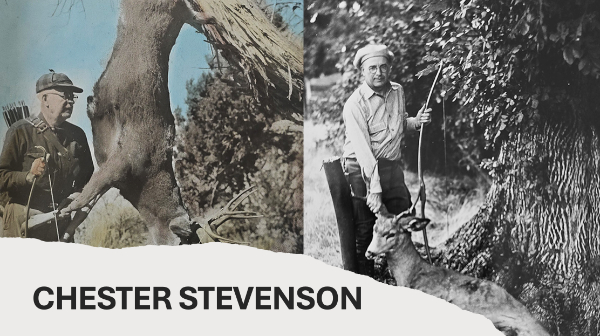
1883 to 1978
Chester Stevenson lived, breathed, and promoted bowhunting during a time of pioneering for bowhunters. He lived and hunted in Oregon and began bowhunting when travel was primitive, and the country was wild. His hallmark in his long life was shear adventure.
In his early years he took a train and then stagecoach into the Upper Mackenzie River country in the Cascade Mountains to go on a one-month solo deer, bear, and wolf hunt. Then, in 1909 he and some pals canoed the Columbia River from Pasco, Washington to Portland, Oregon before that large river and its rapids were tamed by dams.
By profession, Chester (Chet) was a photographer and had his own business called the Kodak Finishing Business. His pictures were excellent at a time when that profession was in its infancy. He made all of his own bowhunting equipment and was an exceptional self-bow maker, who favored yew wood. He influenced and advised all the bowhunting notables of his day – Saxton Pope, Art Young, B.G. Thompson, Fred Bear and others with his precision as a bowyer.
He and his buddies hunted every sort of big and small game, and he kept detailed notes of his hunts from shortly after 1900 up until his death. For over 30 years he authored a monthly column called “The Old Bowhunter” in National Bowhunter Magazine. In these articles Chet told of his many bowhunting adventures and enlightened a generation to take on the challenge of hunting with simple, traditional, archery gear.

1928 – 1982
Bob Swinehart was born in Pottsville, Pennsylvania, and later made his home in Emmaus. He was inspired by Howard Hill at a young age, and fashioned bows and arrows to practice his passion. After college and service in the army, Swinehart finally met his idol and soon to be mentor. They became friends and eventually worked together.
Swinehart was an exceptional archer and bowhunter. Friend Howard Hill said of all the places and people he had the pleasure of hunting with, Bob Swinehart was the best. It was during their time living, working, and hunting together that Swinehart knew he would be going to Africa to pursue the Big Five. While Swinehart hunted local deer in Pennsylvania and other North American game, he is acknowledged as being the first bowhunter to harvest Africa’s Big Five with traditional equipment. Swinehart used longbows in the 100-pound range for most of his African hunting. He appeared on Ripley’s “Believe It or Not” for taking the Black Rhino with his longbow. His book In Africa is about his experiences there.
Bob’s adventures with a longbow inspired him to write Sagittarius, an autobiography of his hunting exploits in America and Africa. Bob Swinehart also shared his exploits with many groups, talking about his hunting experiences and giving shooting demonstrations.
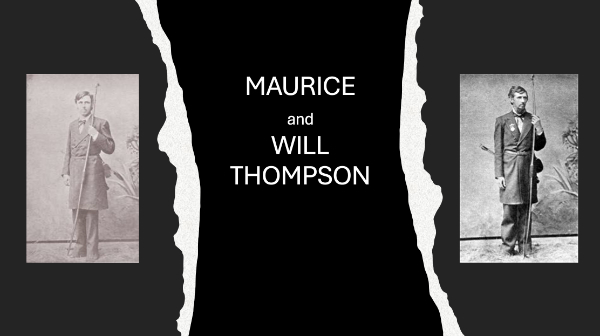
Maurice Thompson—September 9, 1844 – February 15, 1901
There can be no doubt of the impact that Maurice Thompson had on hunting with archery tackle during the late 19th century. In an age when the modern firearm had replaced the bow as an effective hunting tool, his magazine articles and books were the podcasts and YouTube videos of the day. The renewed interest in bowhunting (a term that had not yet been coined) had impacts beyond anyone’s wildest expectations.
Perhaps, in the archery and bowhunting community, he is best known for his book, The Witchery of Archery (1878) about exploits with his brother Will in the wilds of Florida. Chapter names like, ‘Some Notes on Woodpecker-Shooting’ and ‘Bow-shooting with a Hermit’, were quick to spur interest. Many of the chapters were taken from articles that had previously appeared in magazines of the day, like the New York Tribute, Atlantic Monthly, and Harper’s Monthly.
Largely due to the success of the book, he was elected as first president of the National Archery Association. He published his second archery related book, How to Train in Archery (1879) during this same period.
Will Thompson—March 10, 1848 – August 10, 1918
Perhaps he is best known as the younger brother of another Traditional Bowhunters Hall of Fame inductee, Maurice Thompson. We can tag along with many of Will’s exploits afield with his brother, through many of his brother’s writings. But Will also put ink to paper and expressed his joy for the hunt with words reminiscent of Aldo Leopold. Such phrases as ’we were out for the pleasure of the chase’, and ‘I have loved the bow as a weapon of the chase more than any other’, can be found in the November 20, 1879 issue of Forest and Stream. For Will Thompson, the romance of the hunt was alive, as long as his trusty bow was by his side. Will also helped organize the National Archery Association (NAA) in 1879 and was president in 1882 and 1903. He won the very first NAA tournament. He was also an archery medalist in the St. Louis Summer Olympics in 1904, winning both gold and bronze medals.
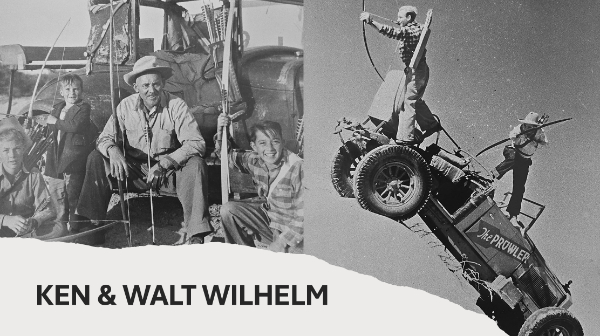
Walter Wilhelm February 1893 – February 1964
Kenneth Wilhelm June 1902 – February 1982
Walter Wilhelm was born in Trenton, Missouri on February 27, 1893, and at the age of three headed west with his family in search of gold. The family lived in a covered wagon. Growing up this way gave Walt a love of the outdoors. He grew up hunting, and was exposed to the bow and arrow at a young age through interactions with native children they lived near in their travels. Walt became an avid archer around 1925 and soon after enjoyed hunting the deserts in California with bow and arrow.
Kenneth Wilhelm was born on June 8, 1902 in Mackay, Idaho where his family was traveling through by covered wagon while prospecting. Ken grew up outdoors hunting and took up bowhunting around 1930. He is also widely known for his involvement in flight shooting. Ken set many flight distance records with hand and foot bows.
They spread the joy of traditional archery through their teaching and shooting exhibitions. Walt and Ken did several short films of their shooting skills and travels in the Mohave Desert with bow and arrow. These activities along with the numerous appearances they did on TV and radio programs showcased traditional archery and bowhunting to the masses. Walt and Ken were also involved in many archery clubs, helping set up courses to get more people involved in traditional archery and bowhunting. The Wilhelm Brothers were exceptional archers and bowhunters who influenced countless numbers of people.

August 17, 1883 – February 26, 1935
Art Young was a true Renaissance man, a decorated athlete who trained for the Olympics as a swimmer, an accomplished violinist, and the definition of a sportsman. He was a master with bow and arrow and a fearless hunter. He was born in Kelseyville, CA, in 1883 and eventually settled in San Francisco to work for the San Francisco Call newspaper.
A fellow legend, Will Compton, taught Young the joy of archery, and through Compton, he met Dr. Saxton Pope and Ishi, and the group regularly hunted together. With self-made bows of Pacific yew, Young and Pope ventured to Yellowstone Park in Wyoming and took six grizzly bears, one huge specimen Young took with a single well-placed shot.
Young never wrote a book but penned numerous articles on his adventures and the effectiveness of an accurate arrow. He may be best known through his exploits in Africa, chronicled in Dr. Pope’s book The Adventurous Bowman, where he killed a massive male lion from twelve yards, and through his Alaska adventures shown in the film Alaskan Adventure, where Young was the first 20th Century bowman to take brown bear, Alaskan moose, and Dall Sheep. In 1926, with George Putnam, who would later document their dangerous exploits in David Goes to Greenland, Young killed a polar bear and a walrus. Through his writing, films, and frequent lectures, Art Young is, alongside his frequent hunting partner Saxton Pope, rightfully known as one of the fathers of modern bowhunting.
1902 – 1977
Cliff Zwickey was a machinist and inventor from Minnesota. While he is not known for his bowhunting exploits, per se, his contributions to traditional bowhunting are unmistakable. He made some yew and Osage bows as well as the Fleetwood bow hinge.
When the Minnesota hunting laws changed to allow the hunting of deer, elk, and bears, most broadheads of the day were made out of thin, easy to sharpen steel, but Cliff realized we needed a stronger broadhead to efficiently get the job done. From his home shop in North St. Paul, the Zwickey Broadhead Company was founded in 1938. There he, with the help of his son John (Jack) invented, designed, and manufactured Zwickey Broadheads. It is the longest continuously running broadhead company in the world.
Cliff experimented with thicker steel than was the norm and arrived on the basic design that is still made today: three layers of steel upfront for strength, two layers down the middle to braze the ferrule onto, and one layer at the cutting edges for easy sharpening, copper brazed and heat treated. This design was patented. Cliff is also responsible for the 5 degree taper on ferrules still used throughout the industry to this day. This was the result of a happy accident: filing away at a 3/8” metal rod to use to form the ferrule sockets used on his broadheads until it looked about right.
In or around 1957, Bear Razorheads hit the market and due to the high profile bowhunting exploits of Fred Bear, many bowhunters switched from Zwickey Black Diamond heads (so named because of their shape, sharpness and black painted finish) to the new broadheads. Zwickey also was the first company to have a four-blade design to use bleeder blades struck directly from the ferrule, as opposed to a slotted design, after being asked to make such a head by well-known bowhunter, Forest Nagler, Chief Engineer at Allis Chalmers in Milwaukee, and thus, the Zwickey Eskimo Broadhead was born.
After being driven nearly out of business, Cliff realized he needed to invent something even more innovative: an unlosable arrow point. Thus, the resulting product was the patented Zwickey JUDO point, combining a series of interconnected springs with a blunt tip for shooting small game and roving, so they could practice “hunting” year around. Archery history was made once again by the small family-owned company from North St. Paul.

